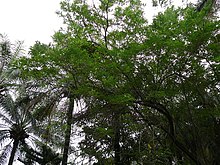| Gliricidia | |
|---|---|

| |
| Gliricidia sepium | |
| Scientific classification | |
| Kingdom: | Plantae |
| Clade: | Tracheophytes |
| Clade: | Angiosperms |
| Clade: | Eudicots |
| Clade: | Rosids |
| Order: | Fabales |
| Family: | Fabaceae |
| Subfamily: | Faboideae |
| Tribe: | Robinieae |
| Genus: | Gliricidia Kunth (1842) |
| Synonyms[1][2] | |
| |
Gliricidia is a genus of flowering plants in the legume family, Fabaceae and tribe Robinieae. Its native range is Mexico to Peru, but Gliricidia sepium has been widely introduced to other tropical zones.[2]
The species G. sepium is a small, deciduous, ornamental tree, cultivated and used for a variety of purposes in tropical regions. The genus name Gliricidia means "mouse killer" in reference to the traditional use of the toxic seeds and bark of G. sepium as rodenticides.[3] The tree is leafless when in flower and bears fruits during April and May in India and countries with same climate. The small flowers (barely 2 cm long) are pale pink and they are borne in dense clusters on bare twigs. Flowers fade to white or a faint purple with age. The flowers attract a lot of bees and some lycaenid butterflies—particularly the Peablue Lampides boeticus and other native birds.
- ^ Cite error: The named reference
Lavinwas invoked but never defined (see the help page). - ^ a b Gliricidia Kunth Archived 2023-11-01 at the Wayback Machine. Plants of the World Online. Retrieved 31 August 2023.
- ^ Abulude, F.O; Adebote, V.T. (2009). "Antibacterial investigation of crude extracts of the root bark of Gliricidia sepium". Continental J. Microbiology (3): 23–26. S2CID 14135175.